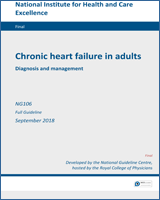From: 9, Referral and approach to care

Chronic Heart Failure in Adults: Diagnosis and Management.
NICE Guideline, No. 106.
National Guideline Centre (UK).
London: National Institute for Health and Care Excellence (NICE); 2018 Sep.
Copyright © NICE 2018.
NCBI Bookshelf. A service of the National Library of Medicine, National Institutes of Health.